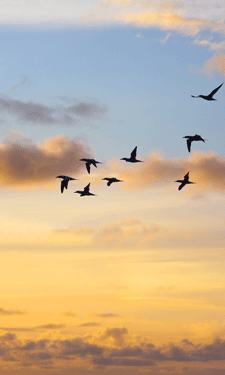 Spring is here, and with the warmer weather and blooming flowers come swarms of migratory birds returning home after the cold North American winter. This time of year is prime season for birdwatchers, better known as “birders,” who are attracted to the concentrated flocks and bright plumage of the breeding birds. You may be familiar with birding, but many may be surprised at the significant impact birders have on the environment and the economy. In 2011, the U.S. Fish and Wildlife Service sought to provide more comprehensive information on the identity of birders and their economic impact with its National Survey of Fishing, Hunting and Wildlife-Associated Recreation. Below, find some highlights from the survey, which helps shed some light on the true value of birding — and by extension, the value of birds.
Spring is here, and with the warmer weather and blooming flowers come swarms of migratory birds returning home after the cold North American winter. This time of year is prime season for birdwatchers, better known as “birders,” who are attracted to the concentrated flocks and bright plumage of the breeding birds. You may be familiar with birding, but many may be surprised at the significant impact birders have on the environment and the economy. In 2011, the U.S. Fish and Wildlife Service sought to provide more comprehensive information on the identity of birders and their economic impact with its National Survey of Fishing, Hunting and Wildlife-Associated Recreation. Below, find some highlights from the survey, which helps shed some light on the true value of birding — and by extension, the value of birds.
47 million: Number of birders, 16 years of age and older, in the United States as of 2011.
88: Percentage of birders who “backyard bird,” aka, watch birds around their homes.
38: Percentage of away-from-home birders, or those who travel more than a mile from home to bird watch on both private and public lands.
53: Average age of a birder in the United States in 2011.
75: Percentage of away-from-home birders who observe waterfowl (ducks, geese, etc.), making those species the most-watched type of bird.
110: Average number of days spent birding for all birders in 2011.
$15 billion: Estimated trip-related expenditures for birders in 2011.
$26 billion: Estimated equipment expenditures for birders in 2011.
$107 billion: Total birding industry output across the United States in 2011.
666,000: Number of part-time and full-time jobs created from birding expenditures in 2011.
$31 billion: Estimated employment income created from birding expenditures, consisting of both employee compensation and proprietor income.
Source: National Survey of Fishing, Hunting, and Wildlife-Associated Recreation, 2011.
Catrina Belt is Parks & Recreation magazine's Editorial Intern.

